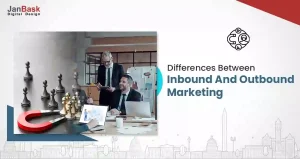

If you ever ask any digital marketer in the digital marketing world, what is the bane of their existence, they will tell you that it is to consistently generate more conversions & sales. To do so, they feed customers with content on websites, social media and through other various marketing channels. However, the online world has given customers ample choices to select from, so what doesn’t engage or capture their attention they quickly move past it, and sometimes halfway through the conversion process they abandon it to move on to the next better choice.
Additionally, not every customer who sees your ads or engages with them will buy your products or services no matter how much you surround them with your ads on the internet, which adds to the headache. In fact, “only 2% of people who visit your website are converting. The other 98% of website visitors who do not convert fall out of your marketing funnel at some point.”
But there is one remedy to this headache and that is remarketing or retargeting those customers who have shown interest in your product/services. After all, isn’t it easier to capture the mind of a visitor or buyer who is interested in knowing you or buying your products rather than those who have no interest? So what do you do? You use B2B remarketing. Through remarketing campaigns, you give a little nudge to the buyers or visitors and remind them of what they were looking at, with a hope that they will visit your site again, and then convert into a solid lead.
So if you own a small B2B business or lead with an established one or just started with a B2B business, this blog is for you. In this blog we will discuss:
Let’s understand B2B Remarketing with a real example...
So you saw Adidas shoes while browsing through Instagram, you clicked on the picture, that redirected you to the official website of Adidas, you selected the size, color and just when you were about to hit on the buy option, you got a call and you forgot about the shoe. It’s been days and you are wondering why are you being notified about shoes on social media profiles, emails, or even messages, and then you finally realize you wanted to buy shoes. So you do it.
You see that’s what remarketing does.
Remarketing is a method that helps businesses target or re-engage with buyers who have already viewed something on their website or displayed interest in the products or services but did not go through the conversion.
But by conversion we just didn’t mean ‘sale’ on your end, it could also mean that they:
So remarketing allows you a second chance to take advantage of the potential customers’ interest shown in the past and propel them to come back to you to finish the conversion. You show specialized ads that promote the product and highlight its relevance to the buyers who already visited it or encourage them to provide information that they didn’t provide in their first visit. Similarly, as a B2B marketer, to keep engaging your leads that visit your website but leave, you use B2B remarketing tactics so that they can come back and give you what you wanted, be it filling the contact form, making a quote, or going through the buying process.
Let’s explain it to you with a few inspiring B2B remarketing examples.
HubSpot: HubSpot business serves different B2B brands with different services. Here is a copy of their landing page:
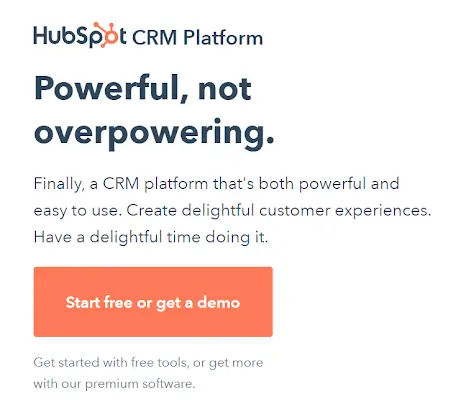
When you click on “Start free or get a demo” you are redirected to another landing page where HubSpot has all different kinds of services to offer and you can choose to start a free trial or get a demo of the services you want.
HayatsPro: It's a B2B eCommerce brand that sells electronics appliances ranging from laptops to printers. This is how their landing page looks like:
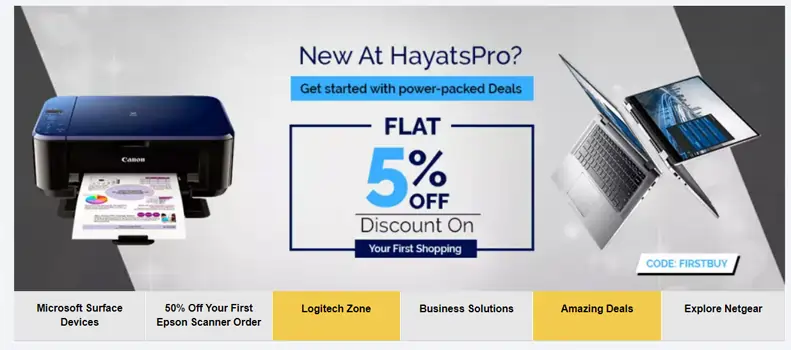
When you click on “Your first Shopping,” the landing page will take you to another landing page “Featured deals” with different deals on products for you to shop.
Let’s see another set of B2B remarketing examples for better understanding.
Salesforce: Its landing page displays a persuasive CTA to remarket to businesses and propel them to take action and try out the business services Salesforce offers.
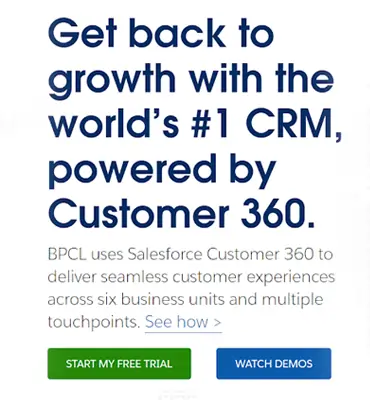
Types of B2B Remarketing
So before starting the discussion on how to create B2B remarketing strategies, let’s first understand the different types of remarketing that you can employ in your B2B remarketing strategy. There are five types of B2B remarketing, namely:
1. Dynamic Remarketing
For this remarketing, you display ads to your users that are related to a particular page or product that they visited. These ads convey to your users how the particular products or services will resolve their pains and want lists in order to lead them to finish the actions that they left incomplete when they first visited your website.
For instance, when you browse on Amazon, they track your every move. Once you show interest in a certain product, it sets a flag, but if you didn’t go through with the purchase and abandoned the cart, in a few days you can be almost guaranteed to get ads about the deals on that specific product, or how it is going to help you look or feel good. That’s dynamic remarketing.
2. Video Remarketing
According to Statista, “People love watching and interacting with video content so much that they nearly spend over 22 billion in video content.” In Video remarketing you display your ads to target B2B businesses that have seen videos about your products or services or have visited your website. These audiences can be the ones who keep engaging with the video content you produce on your YouTube channel or elsewhere like Facebook and LinkedIn. So you create and display ads about the product or services they showed interest in between the videos your B2B target audience is watching. Your goal is to keep engaging the target businesses and show them content about the value of your products or services for their businesses and convert them eventually.
3. Display Remarketing/Standard Remarketing
Display marketing uses Google display network or social sites like Facebook to target B2B businesses who use “search intent” in their search for solutions to their pain points or want lists. For instance, if your visitor uses Google Chrome as his website browser, it releases a cookie that identifies and tracks the user after they exit your website. Later, when they visit other websites within the Google Display Network, your Google ad will pop up on their screen in either a text or image format.
4. Customer List Remarketing
This remarketing type is data-based, wherein you utilize the data that your target B2B prospects have shared with you when they signed up for your website forms. Using this information, you display remarketing ads to your target B2B businesses when they sign in through Google. This type of remarketing not only helps you know more about customers as you work on reaching more target businesses but also enables you to convert them. For instance, an eLearning platform wants to show ads about Course deals to people who attended a seminar on a particular IT course and shared their contact details in the past month.
5. Remarketing Lists For Search Ads
This remarketing type comes in handy to capture the attention of those B2B business prospects that may have visited your website but never returned back. You get their attention by tailoring your ads to suit their search intent and position those ads in front of them so as to keep drawing them to your business and eventually incite engagement. Remarketing lists for search ads allow you to put your brand right in the center of your target B2B business leads as they go around searching for solutions through Google and other search engines.
Benefits of B2B Remarketing
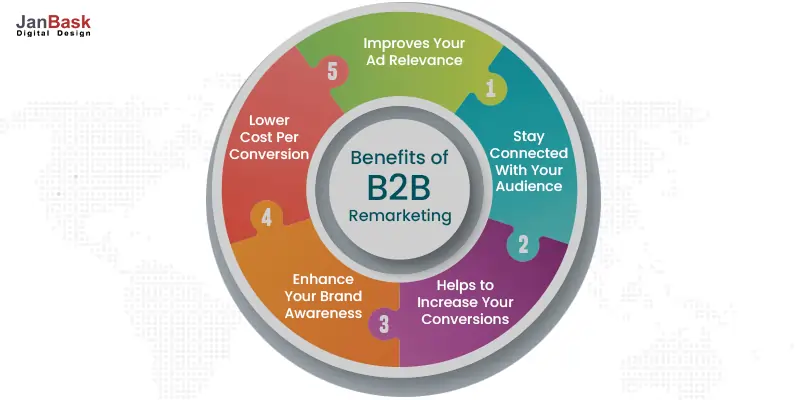
Since you now know how the different types of B2B remarketing works, let’s move on to understanding how B2B remarketing will benefit your business:
Stay Connected With Your Audience
96% of visitors leave without converting and 49% of visitors browse a site 2-4 times before they make a purchase. However, when you apply remarketing strategies not only you can re-engage your customers who left your website to revisit you and propel them to complete the buyer’s journey. Since you know your target audience and that they have shown interest in your products or services, you can follow them from site to site to get their attention and remind them of what they already need or want to bring back to you whether it’s after a week or a month.
Helps to Increase Your Conversions
Remarketing helps you reach out to those visitors who entered your website, exploring your products or services but have not yet decided to make a purchase. Your remarketing campaigns display ads to them even if they are not on your site, making your exposure 10 times higher than other marketing strategies and re-engages them, re-captures their attention & propels them to complete the customer journey that they didn’t take before.
Enhance Your Brand Awareness
When you showcase the same kind of content, slogan, ad, or even logo to your customers, it not only heightens your brand exposure but also helps you foster stronger brand visibility and brand recall. How? Remarketing enables you to establish brand awareness in the early stage of the purchase process and since your customers are already in contact with your ads multiple times as a result, you stay on top of their minds when they are making a purchase.
Lower Cost Per Conversion
Remarketing offers a lower cost per conversion than traditional SEO campaigns. How? Since you already know the target audience and what they like, you really don’t have to blow your marketing budget on them without a surety that they will convert. Clicks on remarketing ad campaigns provide lower cost per click and therefore low cost per conversion, which naturally results in higher ROI. But you need to be careful about running remarketing on its own if you don’t have a decent amount of traffic coming to your website.
Improves Your Ad Relevance
Since you target visitors you know have been to your website before, you want to create ad campaigns that are highly targeted and relevant to them. So that not only do the ads drive them back to you but also propels them to make a purchase or connect with you. Moreover, using remarketing allows you to even create a wide range of ads based completely on which pages users have visited or shown interest in. Though targeted ads are also an integral part of marketing, remarketing enhances your ad campaign’s relevance. Not every customer converts during their first visit or once he sees the marketing ad but if you continue to stay in front of the prospective customer’s mind that reminds him what he wants and in what channel, eventually it leads to him coming back to you and therefore, better loyalty and higher conversions.
So far, we understood what B2B remarketing is, its types, and some major benefits of remarketing for your B2B business. Next, we move on to discuss how you can make your B2B remarketing ad campaigns successful.

We know remarketing strategy definition, its benefits and understand that it’s an incredible marketing tool to boost conversions & ROI. Now you must be wondering how I can create a strong remarketing strategy for my business? Well, worry not, here we are providing you a step-by-step guide to help you create a remarketing strategy that can take your remarketing efforts to the next level and boost your ROIs:
You cannot start a marketing campaign without setting a goal first, similarly for an effective remarketing strategy, you should be aware of what you are trying to achieve with your ads. And being a B2B set up, your goals cannot be around earning just higher sales. Your idea of conversion can be about a prospective client giving you contact details for a free ebook or subscribing to your newsletter. So setting goals before you launch your remarketing strategy is a must and try to avoid creating one ad that you hope will serve different audiences. Instead, you should focus on setting some specific goals for each remarketing campaign and then try to achieve them accordingly.
Whether you have a B2C or B2B business, your audience is the key to have a successful remarketing campaign. Once you are clear on what kind of goal you want to set up for your remarketing strategies, your next step is to define an audience for your campaign. Deciding this so early in the remarketing strategy ensures that your ads are being displayed to the most relevant people so as to reap the maximum ROI from your campaign. The rule is simple: prioritize the audience who are further down the conversion funnel as they promise higher conversion. Fight for their attention and for ad space on their screens or around them to reach them. Less committed audiences or those who are just at the beginning stage of buying stage may get less of your attention if they fit the remarketing campaign goals. But in its entirety, you should target and retarget the audience that has shown interest or intent to buy your product or services.
You have various options to employ your remarketing campaigns with search engines like Google to popular social media platforms like Facebook or Instagram. So once you have decided your remarketing goals, the type of audience you want to reach, the next step is to decide where you want to reach them. We will discuss the benefits of social media later in the blog but to just mention it briefly, social media can also act as referral marketing with shares, comments, and reposts from customers who liked your products and services, not only widening your brand exposure but also bringing you new prospects. While if you opt for search engine remarketing, in this method, your ads or campaigns will follow your customers across any websites, this helps you stay in their field of vision, across the web, not just on social media you’ve selected and encourages them to revisit your website. So you can either go with one or both, decide what suits your budget, remarketing goal, and audience, and plan accordingly, since both channels have immense potential to get you leads and conversions.
When you intend to capture your visitors’ attention, re-engage them and draw them back to your website so that you can convert them into customers, it’s recommended that you create different landing pages for your website. Why? Well, because these visitors can be at different buying journeys, some can be at awareness, some can be at consideration stage or some can be even at repurchase stage. To ease their user experience, don't let them explore your whole website and just simply redirect them to a landing page that has what they are looking for based on where they are in the funnel. Like target audiences, you can classify the visitors into two sections: 1) who almost convert and 2) who spend the most time on your website without converting. This will naturally help you narrow down your remarketing strategies and save your time, money, and efforts.
No matter how amazing, meaningful and relevant your content is, it will always fall short of reaching its potential if you are not targeting readers with remarketing campaigns. After all, you just don’t want them to consume what you want to share about your company or product, you also want to encourage them to sign up or buy your services or products to generate leads through webinars, eBooks, or digital downloads. So rather than constantly promoting your products or services, embrace the magic of highly effective content marketing strategies. Provide content that delivers insights, information, addresses, and resolves the pain points of your prospect. Doing so will not only help you gather useful data about your audience but also help you convert them with an ad copy that engages them and resonates with them.
We all understand the significance of utilizing email marketing tactics to boost leads and convert them into customers. And in B2B remarketing, email lists help you identify and nurture prospects better since 42% of B2B buyers prefer to communicate with brands via emails. Additionally, it's more cost-effective than social media advertising or PPC. All you need to do is to curate an email retargeting list for customers based on where they are at the stage of buying cycle or what type of content they would find relevant. However, ensure that you are not sharing the same content to your entire email list. Segment your audience, and curate the list of subscribers based on their firmographic data to develop personalized, relevant, and meaningful content from the very first interaction.
If “95% of B2B marketers utilize social media content in some form,” then why do you want to stay behind? It’s now an undisputed fact that not every visitor on your website is your next conversion, he can simply be there to explore your site and then leave it. Or maybe he went through the buying process but abandoned the cart at the last moment for some reason. Now that’s where social media remarketing comes into the picture. By using retargeting campaigns on social media, you can keep your potential customers updated about latest products/services, testimonials, discounts or upcoming sales, anything and everything that creates a recall factor. So go ahead and utilize social media remarketing to regain the interest of the “ones who got away,” especially when there are over 3.96 billion people in the world who are using social media.
Since you are most likely to engage and sell to an existing B2B customer, it becomes essential to focus on post-purchase remarketing. What is it? You may ask. Post-purchase marketing is all about interacting with your customers or clients after they make a purchase. It is an important marketing concept to not only help you boost customer retention but also get you their brand advocacy. So, post-purchase remarketing is all about retaining the interest and buying power of the customer with your brand. After all, you have invested a lot of time, effort and money getting the customer’s attention and bringing them to finish their buyer’s journey, so why waste it? Use post-conversion remarketing tactics to keep them hooked on your brand. Send a post-sale thank you mail, encourage guest users to create an account or shoot them follow-up emails about their purchase or subscription. Focus on re-engagement and personalized messages or mails to stay in touch with them even after a purchase. This will optimize your users’ experience, boost customer retention and significantly drive your profits.
This is another crucial and an integral part of your remarketing strategy which is to run your ads and track their progress. Doing so will not only help you know what ads are working for you and not but will also enable you to tweak the strategy as you go. Saving your time and effort. However, you don’t have to spend too much budget on monitoring or analytical softwares, many advertising platforms come with in-built analytics. These in-built tools give you detailed reports on the results of your campaigns with features like tools to measure engagement or conversion on each ad. So utilize this marketing method to recapture the attention of your customers who have already shown interest in your brand and get that boost in your conversion and ROI.

Follow these best practices to give your current B2B remarketing strategy a push and see the results like never before:
It’s wise to assume that not all of your website visitors will be interested in the same product. Imagine the horror of displaying ads of “dog food” to a customer who showed interest in “cat food.” We know it’s a poor analogy but you get the meaning, right? You’ll have much more success with your remarketing campaigns if you know how to retarget customers based on their preferences rather than homogenizing their pain points and want lists. So segment your customers on the basis of the time they spend on your site, number of viewed pages, and even how many times they visited a particular page. This will get you a better overview of which products or services would be more appealing to your visitors. Additionally, you can create different CTAs and link them to goal-based pages on your site. Doing so will ensure that you are successfully addressing your visitors’ needs in a more direct manner and solving their needs effectively.
You know what kind of audience you want to retarget or what type of buyer’s persona has generated interest in your brand. So now what? How will you recapture their interests? And what about those visitors who have shown interest but drop off the funnel because they didn’t find anything that excites them? That’s where customer incentives or discounts and other incentives come to the rescue. Customer incentives can become an incredible tool to recapture the attention of your visitors and retain it until he finishes his buyers’ journey. So whether you are offering discounts, free gifts, or the opportunity to win big prizes, ensure your incentives and special offers hold relevance to them. To do that, research about your customer base to understand what originally drew them to you and what would convince them to shop again.
As we know remarketing is all about directing your marketing efforts towards users or customers that have shown interest in your product or services but somehow didn’t go through the funnel. But sometimes it is also useful to target those customers who have shown or have similar interests and behaviours like your existing customers. There are certain tools that will help you in this endeavour for instance, both Google and Facebook’s advertising platforms allow you to create email marketing lists that target new users with online preferences and likes.
So, go ahead and try Customer Match on Google Ads and Lookalike Audiences on Facebook Ads that transform your email lists into new PPC leads.
In content remarketing, you track those users who visited your website but didn’t create a lead so you start displaying or repurposing content to generate interest in them. You need to create and optimize your content particularly targeted to dovetail with your customers’ interests. This propels them to come back to you and perform the action you hoped for like making a purchase or subscribing to your newsletter. There are many ways through which you can remarket and ‘re-share’ content so as to squeeze the maximum benefit from the content remarketing. For instance, sharing positive feedback from customers on your homepage or adding customers’ Instagram snaps or FB posts links to your products or services on your product pages for a genuine and valuable social proof.
Though, it is understood that every B2B business, be it small or big, is different from the other. What works for someone may not work for you, what B2B remarketing strategy brought your competitors lead, may not do the same for you. So we suggest you to be patient, take some time, do research well and then put in the effort to produce high-quality, engaging, meaningful and unique B2B remarketing campaigns that have relevant to offer. You’ll be pleasantly surprised by the results.
No doubt, B2B remarketing strategies are an incredible way to recapture your leads, enabling you to stay ahead of your competitors because most of them don’t take the time to try it, or if they do, they don’t do it well. Hopefully, this blog has cleared your doubts or questions regarding what B2B remarketing strategy definition is, how to use it & how to create a successful B2B remarketing strategy. Follow the step-by-step guide diligently, be mindful of the effective practices that we share, every time you want to create a B2B remarketing strategy and harness its power.
So what are you waiting for? Come on, get up! Create B2B remarketing campaigns, test them, tidy up your funnel and see the conversion of those precious leads!
Hey, if you feel stuck while creating a B2B remarketing strategy or have doubts about a B2B remarketing, feel free to reach out to us! Or just drop us a comment, we love talking to you!
A
What is the technique to build my B2B marketing strategies for my business? As I am new in the business world and want to be ahead in the competitive market.
J
Hi, Thank you for reaching out to us with your query. Drop us your email id here and we will get back to you shortly!
C
Hi! I want to hire a professional for effective B2B marketing strategies as my previous team members are not familiar with the new trends. Can your team help me with this? Waiting for your reply!
J
Hello, JanBask offers online training to nurture your skills and make you ready for an amazing career run. Please write to us in detail at help@janbaskdigitaldesign.com. Thanks!
Z
Hi! I am satisfied with the information mentioned above in the article to build a strong B2B marketing strategy as it takes a lot of time, and effort. All thanks to your team!
J
Glad you found this useful! For more such insights on your favourite topics, do check out JanBask Digital Design Blogs and keep learning with us!
J
The above mentioned B2B marketing strategies are really helpful as I was looking for such information. You should also write an article related to them! Pls share the link if it is already written..
J
Thank you so much for your comment, we appreciate your time. Keep coming back for more such informative insights. Cheers 🙂
K
Hi! Thanks for the information it is very helpful for the beginners as well as for the business persons who are in this business for a long time.
J
Glad you found this useful! For more such insights on your favourite topics, do check out JanBask Digital Design Blogs and keep learning with us!
R
Very nice written post, earlier I thought remarketing and retargeting is the same but this post has removed all my confusion.
J
Glad you found this useful! For more such insights on your favourite topics, do check out JanBask Blogs and keep learning with us!
S
I heard about B2B marketing but after going through this blog now i understand what it is exactly.
J
Glad you found this useful! For more such insights on your favourite topics, do check out JanBask Blogs and keep learning with us!
M
As I am new to marketing, and recently joined and don’t have any idea about how to create a marketing strategy, the way explained in this post is really easy to understand.
J
Glad you found this useful! For more such insights on your favourite topics, do check out JanBask Blogs and keep learning with us!
D
Do janbask provide B2B marketing services through digital marketing services , if yes then please tell me the best way to reach your consultant.
J
Hello, JanBask Digital Design offers responsive & feature-rich web design, development, digital marketing, and consultancy services. For any requirements, please write to us in detail at info@janbaskdigitaldesign.com. Thanks!
L
I am definitely going to follow the best practices listed in this blog to develop remarketing strategies.
J
Glad you found this useful! For more such insights on your favourite topics, do check out JanBask Blogs and keep learning with us!
J
Hi there! This article has a great content.
J
Thanks Jason.